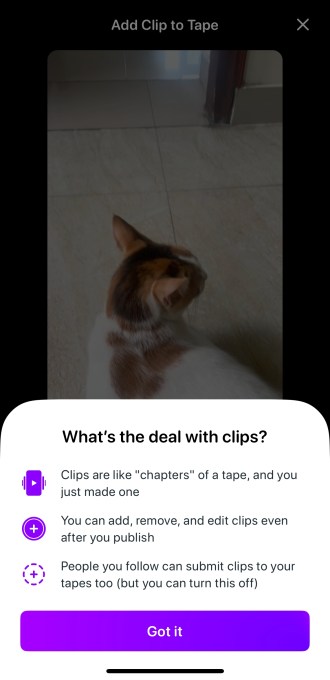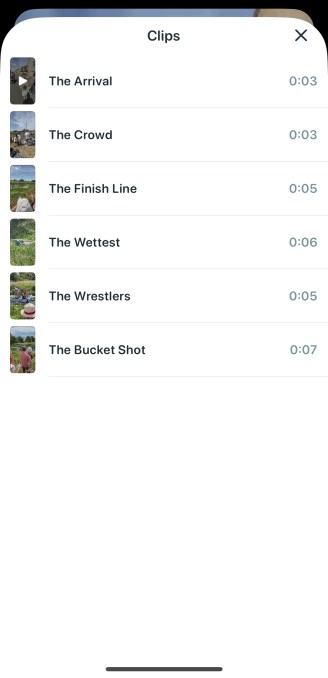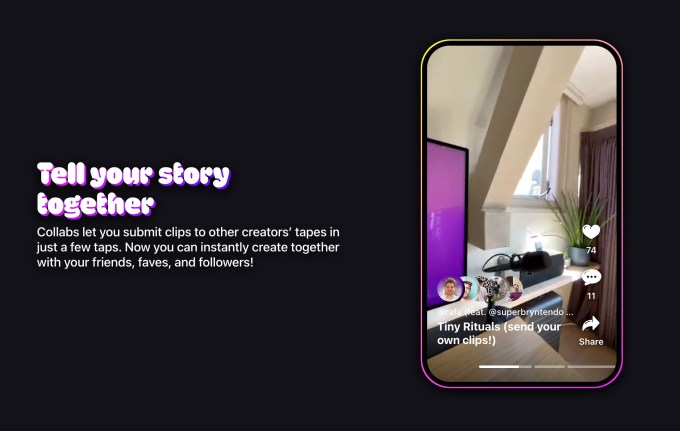All major social networks, including Instagram, TikTok, and Snapchat, have their own take on how collaborations should work. But most of these features have constraints like time limits and the number of creators included in a clip. A new app called Along wants to remove all these restrictions to allow infinite-length collaboration videos with multiple creators.
The app is based on the concept of infinite videos called “tapes.” A creator can start a tape by recording a clip and later add as many clips as they want. They also can enable collaboration for a tape, so other creators can add their own videos on a similar theme. Once the original poster approves these collaborations, they’re added to the tape.
The idea is similar in a way to the “Add This” feature that Meta recently rolled out to its short-form video offering, Reels. Except in this case, users are collaborating on a video “tape,” curated by the original poster, not simply contributing to a trend page.
Along says it’s targeting the new app at creators who often want to collaborate with their viewers.
Though the app is invite-only for now, TechCrunch readers can access it first here: https://along.video/invite/techcrunch.

Image Credits: Along video
While watching a tape, users can move between individual clips by swiping left or right. They can also move to the next tape by scrolling down the vertical feed — just like on TikTok or Reels.
If they tap on the “clips” bar at the bottom of the screen, they can access a table of contents that allows them to easily hop to a particular section. This is useful if someone is following a creator posting travel vlogs every few days. If users have seen the earlier clips, they can directly skip to the latest clip, for example.

Image Credits: Along
To get started, creators can record a 60-second clip directly from the app’s camera or import an already existing footage of up to five minutes. They can add links to a website or tag users in the clip. Link tagging is handy for tapes for product reviewers and references to other social profiles of a creator — no need for “link in bio” here.
Who can collab is also in the creator’s control. Video makers can set collaboration to off, everyone or people they follow — the latter being the default.
Users, meanwhile, can join a tape by tapping the “collab” button that appears next to the carousel displaying avatars of collaborators on the tape.
The startup was founded in 2020 by Bryn Jackson, who previously worked at GitHub and Figma. The Los Angeles-based company raised $2 million in pre-seed last year from investors like Ludlow Ventures, Fuel Capital, Form Capital, Ev Williams and Hidden Ventures.
The idea for Along occurred to Jackson after having an issue with a YouTube video upload that couldn’t be addressed without losing the comments and views. The problem got him thinking about how internet video had hardly evolved over the years. Jackson said he wanted to create a new format that ditched the notion of internet video being a static, uneditable file.
The founder says the app doesn’t have a steep learning curve, as most creators already know how to create videos in the short format. Plus, the app offers new users introduction tapes and formats for collaborations to get started.

Image Credits: Along
The company has tested the app with more than 500 users for over a year to understand how this format could work. Jackson said the biggest learning from the early tests was to perfect one feature, in this case, “collabs.”
“We always looked at collabs as one of many convenient side-effects of the format we were building, but it turned out it was the easiest thing for people to latch onto both as a fun mode of creation and a clear reason to use the platform,” he said.
For the time being, Along is free to use, and the company is still figuring out the monetization model. The startup is aiming to publicly launch after a few months of the invite system.
Jackson said the team of four at Along is now working on features like reordering clips in a tape for creators and a bookmarking feature for consumers. The company is also thinking about ways to export tapes to other major social platforms.
As Instagram is making many unpopular changes to its app, many users have been trying out alternative social networks like BeReal, Poparazzi, Locket, Yubo and LiveIn. Along hopes its video format could appeal to a young audience that is looking for the next big social media format.
Along is currently available only on iOS, and has a waitlist system. (This link will provide access.)
from TechCrunch https://ift.tt/F4l9D6m
via IFTTT
Comments
Post a Comment